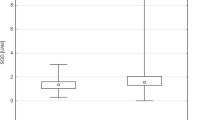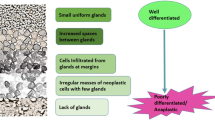Abstract
The activities of glutathione peroxidase (GSH-Px) and superoxide dismutase (SOD) and the levels of copper, zinc, and malondialdehyde were determined in 21 age-, sex-, and body-mass-index-matched prostate cancer patients; 50 patients diagnosed with benign prostatic obstruction (BPO) were compared to 50 healthy male subjects acting as controls.
The patients were divided into two groups depending on the stage of the disease (group 1 [organ-confined] and group II [advanced disease]) and into three subgroups according to differentiation criteria: subgroup A (n=5, Gleason sum 2–4, well differentiated); subgroup B (n=9, Gleason sum 5–7, moderately differentiated), and subgroup C (n=7, Gleason sum 8–10, poorly differentiated).
The MDA levels were higher and the antioxidant activity and Zn levels lower in the prostate cancer groups than in the healthy control and BPO groups. These results confirm the value of therapies aimed at increasing the antioxidant capacity and encourage the use of plasma and erythrocyte Zn levels in the differential diagnosis of BPO and prostate cancer. The MDA levels can be used in the diagnosis and follow-up of prostate cancer.
Similar content being viewed by others
References
A. E Norrish, R. T. Jackson, and C. U. McRae, Non-steroidal anti-inflammatory drugs and prostate cancer progression, Int. J. Cancer 77, 511 (1998).
A. L. Potosky, B. A. Miller, and P. C. Albertsen, The role of increasing detection in the rising incidence of prostate cancer, JAMA 273, 548 (1995).
A. M. Baker, L. W. Oberley, and M. B. Cohen, Expression of antioxidant enzymes in human prostatic adenocarcinoma, Prostate 32(4), 229–233 (1997).
D. G. Bostwick, E. E. Alexander, R. Singh, et al., Antioxidant enzyme expression and reactive oxygen species damage in prostatic intraepithelial neoplasia and cancer, Cancer 89(1), 123–134 (2000).
V. Y. Zaichick, T. V. Sviridova, and S. V. Zaichick, Zinc in the human prostate gland: normal, hyperplastic and cancerous, Int. Urol. Nephrol. 29(5), 565–574 (1997).
M. Brys, A. D. Nawrocka, E. Miekos, et al., Zinc and cadmium analysis in human prostate neoplasms, Biol. Trace Element Res. 59(1–3), 145–152 (1997).
V. Y. Zaichick, T. V. Sviridova, and S. V. Zaichick, Zinc concentration in human prostatic fluid: normal, chronic prostatitis, adenoma and cancer, Int. Urol. Nephrol. 28(5), 687–694 (1996).
R. N. T. Coffey, R. W. G. Watson, N. J. Hegarty, et al., Thiol-mediated apoptosis in prostate carcinoma cells, Cancer 88(9), 2092–2104 (2000).
J-Y. Liang, Y-Y. Liu, and J. Zou, Inhibitory effect of Human prostatic carcinoma cell growth, Prostate 40, 200–207 (1999).
H. Biri, H. S. Öztürk, M. Kaçmaz, et al., Activities of DNA turnover and free radical metabolizing enzymes in cancerous human prostate tissue, Cancer Invest. 17(5), 314–319 (1999).
S. P. Fitzgerald, J. J. Campbell, and J. V. Lamont, The establishment of reference ranges for selenium. The selenoenzyme glutathione peroxidase and metalloenzyme superoxide dismutase in blood fractions, Fifth International Symposium on Selenium Biology and Medicine, pp. 20–23 (1992).
P. A. Pleban, A. Munyani, and J. Beachum, Determination of selenium concentration and glutathione peroxidase activity in plasma and erythrocytes, Clin. Chem. 28, 311–316 (1982).
S. K. Jain, Hyperglycemia can cause membrane lipid peroxidation and osmotic fragility in human red blood cells, J. Biol. Chem. 264, 21,340–21,345 (1989).
Author information
Authors and Affiliations
Rights and permissions
About this article
Cite this article
Yilmaz, M.I., Saglam, K., Sonmez, A. et al. Antioxidant system activation in prostate cancer. Biol Trace Elem Res 98, 13–19 (2004). https://doi.org/10.1385/BTER:98:1:13
Received:
Revised:
Accepted:
Issue Date:
DOI: https://doi.org/10.1385/BTER:98:1:13




